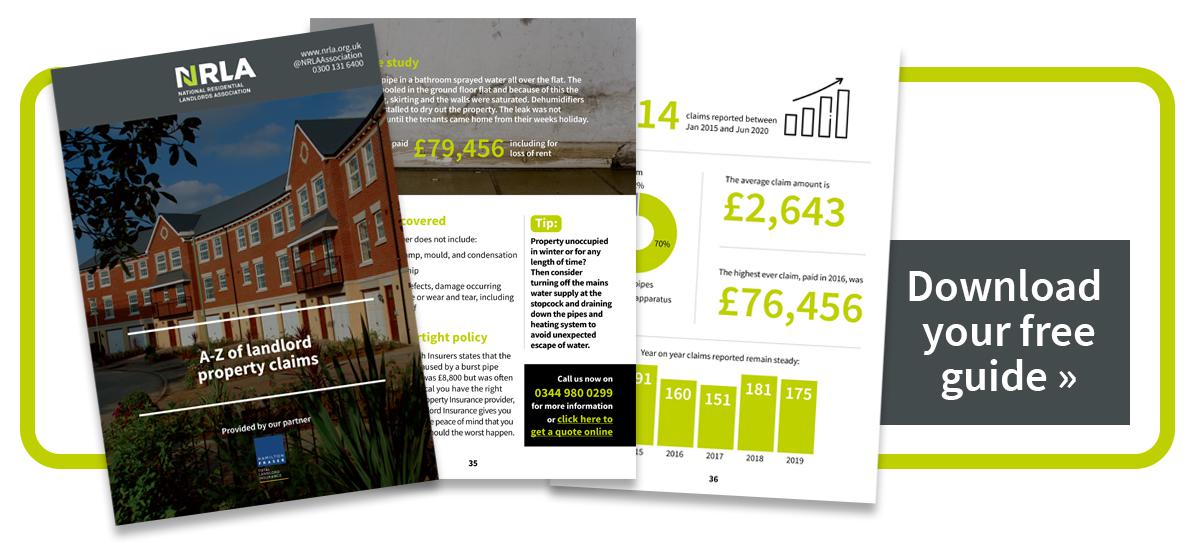

The complete guide to protecting your rental property from storms
Stormy weather is not unusual in the winter and there has been an increase in severe storms in recent years. Over the past decade, property owners across the UK have seen some of the worst weather damage on record, with many suffering uninsured losses due to torrential rain, gale-force winds and flooding. The UK Environment Agency has warned that we’re going to get more intense bouts of flooding, and scientists predict that climate change is likely to lead to higher storm surges as sea levels rise.
February is the peak month for storm damage claims, which are the second most common type of insurance claim, according to NRLA Property Insurance provider, Hamilton Fraser Total Landlord Insurance. The hazards most associated with storms are roof tiles cracking, trees falling, flooding and fences collapsing. In fact, between 2015 and 2020, roof damage accounted for 71 per cent of storm claims, with an average claim of £1,154, typically as a result of high winds causing tiles to fall off the roof. In this article, Hamilton Fraser Total Landlord Insurance share their insights into how you can make sure you’re aware of an approaching storm and take action before it hits, what you can do to prepare your rental property to limit the impact and what you should do if your property is hit by a storm.

1. Watch the weather
Changing weather patterns are increasing the likelihood of storm damage, with storms sweeping into parts of the country earlier in the season. The Met Office’s UK Storm Centre runs a new list of storm names from early September to coincide with the start of autumn, when the likelihood of low pressure systems and the potential for named storms increases.
In response to the increasing frequency and intensity of storms in the UK, the Met Office launched ‘Name our Storms’ in 2015. The initiative is designed to raise awareness of the potential impacts of severe weather before it arrives, aiding the communication of approaching severe weather and helping the public to keep themselves and their property safe.
A storm will be named when it has the potential to cause an amber or red warning due to a combination of both the impact the weather may have, and the likelihood of those impacts occurring. The impacts of Storm Ciara and Storm Dennis in early 2020 are still fresh in many people’s minds. More recently, Storm Aiden in October 2020 followed by Storm Bella over Christmas 2020 brought 100 mile per hour winds resulting in floods, although we don’t yet know the full costs.
It’s too early to anticipate what weather the rest of this winter will bring, but it has been a particularly bad 12 to 24 months for named storms, highlighting that landlords should pay particularly close attention to their approach, so that they can be prepared for severe weather before it hits. There have been 45 major UK storms worthy of being named since November 2015.
Hamilton Fraser Total Landlord Insurance research shows that maximum gust speeds closely correlate with storm claims – as gust speeds increase, the payout increases too. For landlords, this information highlights the importance of being prepared.
Forewarned is forearmed - thanks to improvements in weather forecasting, there is no excuse to be unaware of an approaching storm these days, as famously happened with the Great Storm of 1987. So be sure to check the Met Office weather forecast regularly to make sure you are prepared.
2. Communicate with your tenants
If strong winds or stormy weather are predicted, you may be in a position to visit your rental property to make emergency preparations. However, you are required to give 24 hours’ notice before visiting a tenanted property and this may not be possible if the storm is already on its way. In this situation, your tenant may be willing to let you access the property so long as you explain the situation.
If you’re unable to access the property yourself, you should still contact your tenant to check that everything is in order and secure.
Here are some of the steps you or your tenants can take to protect your property if there is a weather warning:
- Check loose roof tiles and guttering - these account for well over half of Hamilton Fraser Total Landlord Insurance’s storm damage claims
- Dismantle large garden furniture and store indoors or in a shed, along with any other loose items such as plant pots or children’s toys, to prevent them causing damage in high winds
- Store lawnmowers and other electrical garden items away to prevent them from getting damaged
- Reinforce windows if a very severe storm is predicted - plywood is a cost-effective way to do this
- If there’s a flood warning, providing your tenants with sandbags will help keep water from backing up into the property
- Make sure tenants close and securely fasten all windows and doors
Checking in with your tenants and taking emergency preventative measures will reduce the risk of damage to your property and help protect your tenants and passers-by, for example in the event of a roof tile coming loose and crashing to the ground.
It is of course much easier to make sure your property is storm-ready if you have a good relationship and clear channels of communication with your tenants. A strong relationship will also help facilitate regular property visits and inspections, which we recommend carrying out every six months.
It’s important to carry out inspections in daylight so that you can easily inspect both the interior and exterior of the building. The roof and garden are the areas to pay particularly close attention to when it comes to mitigating against storm damage.

3. Get your rental-property storm ready
In the event that a storm arrives with little warning, regular maintenance is of course the best way to make sure that your property is storm-ready. This will also help to limit the impact of a storm on your rental property if you’re unable to access the property or reach your tenant at short notice.
By routinely following the steps below once or twice a year, you will reduce the likelihood of storms causing damage to your property.
Clear gutters and drains
Clear your gutters, downspouts and drains of debris such as leaves, moss and twigs that might create a blockage, leading to leaks or overflow into the property. A good time to do this is late autumn, when the majority of leaves have been shed but before temperatures drop and water starts freezing in the gutters, causing them to pull away from the building. It is the landlord’s responsibility under Section 11 of the Landlord and Tenant Act, 1985, to maintain and repair external structures, including drains, gutters and external pipes.
Trim trees
Cut back any low-hanging or loose tree branches that could cause damage in strong winds, particularly if they overhang areas where people may be walking or are in close proximity to your or someone else’s property. This is best done in winter when, with leaves gone, it is easier to assess what needs pruning. Dying branches, exposed roots and peeling bark are all signs that a tree isn’t healthy.
Inspect the roof and carry out repairs
Replace any loose, cracked or broken roof tiles or slates – weak points will be compromised in severe weather. Broken tiles on the ground are a clear sign of existing damage. Remember to also inspect the chimney for cracks or loose brickwork and make sure it’s fitted with a storm collar to prevent water leaking into the loft. It’s a good idea to inspect the roof before winter to prepare, and after to assess whether there’s been any damage.
Check windows and doors
Water damage is one of the biggest problems landlords experience during severe weather, so check that windows and doors are water tight and secure. In extreme circumstances, you can board up windows with plywood or if your property is particularly exposed, perhaps consider installing shutters that can be more easily closed to protect windows.
Secure fences
Fence panels are usually excluded from insurance policies in the event of storm damage. It’s therefore important to make sure they are properly secured to reduce the risk of them being lifted up by heavy winds and causing damage during a storm. Check that posts aren’t rotten and replace any fencing with a strong, weather resistant option. Remember to also check that garden gates are in good working order and kept closed.
4. Get landlord insurance
Having comprehensive landlord insurance in place provides peace of mind that you and your property are covered should the worst happen and you find yourself having to pay out for repairs. Storm damage can be very expensive to rectify. For example, in 2018 we paid out £38,791 after heavy rainfall led to flash floods in Birmingham, causing extensive damage and meaning that the tenants had to be relocated. Although this is a worst case scenario, the average claim for flash floods is £17,708, so it pays to be protected.
A comprehensive policy like Hamilton Fraser Total Landlord Insurance’s Premier policy will not only cover the cost of repair work, but also loss of rent or alternative accommodation.

What should you do if your rental property is hit by a storm?
Despite your best efforts to reduce the impact of a storm, in the event that your property suffers storm damage, it’s important to stay in close contact with your tenants. Your tenants’ safety is the priority.
If the property has been flooded, the gas and electricity must be turned off. In this situation, the local authority or emergency services may decide to evacuate the property. If a natural disaster has occurred and the property is uninhabitable, the onus is on the local council to provide alternative accommodation. But if, as the landlord, a fault that you are found to have known about but not fixed has caused the flood, then you may be obliged to pay for alternative accommodation yourself.
It’s always best to contact your insurer as soon as you can after a storm has caused damage to your property, to avoid delaying your claim. You should also take time and date stamped photographs of the damage to show your insurance provider. Wait until you have spoken to your insurer before undertaking any repair work as they may appoint a specialist to inspect your home to assess the damage.
As a landlord, there is much you can do to protect your rental property against storms, from keeping an eye on the weather and having a good relationship with your tenants, to carrying out regular maintenance and inspections. Prevention is always preferable to cure and as a landlord it is your responsibility to make sure your property is safe and secure.
With severe weather events on the rise, winter is an increasingly challenging season for even the best prepared landlords. Remember, standard home insurance isn’t designed for rental properties – you need specialist landlord insurance that will provide cover if your buy to let property is damaged by severe weather. Hamilton Fraser Total Landlord Insurance was created to meet the specific needs of landlords. We don’t penalise for your renting choices, uniquely our policies accommodate for housing benefit tenants, students, houses in multiple occupation and working tenants with no difference in cover or price, offering peace of mind should the worst happen.
For more information on claims, Hamilton Fraser Total Landlord Insurance’s A to Z of Property Claims eBook is a practical guide, packed full of useful advice to help you understand more about claims, their causes and what your policy will and won’t cover. Download your free copy in exchange for a landlord insurance quote.



